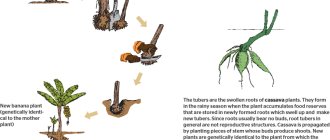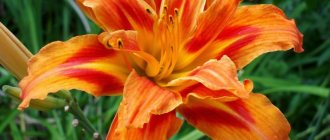It is rare that a garden plant can boast of an abundance of flower colors, ease of maintenance and long flowering periods, pleasing to the eye. Beginning to bloom already in June, daylilies in pots, containers and just on the ground produce many flower stalks, replacing one another. By the way, if you plant a daylily in a container or pot, it will bloom even earlier, because the container will warm up faster than the soil in the garden.
How to plant and grow daylilies?
Tips for growing daylilies
Daylilies have been leading the rankings of popular perennials for many years. They have undeniable advantages: they are unpretentious in cultivation and care, decorative throughout the season, bloom for a long time, and the collection of varieties and hybrids includes tens of thousands of plants with flowers of different shapes and colors.
Variety of varieties
There are over 30 thousand varieties of daylily, each of them has its own characteristics; the real decoration of a summer cottage are the terry varieties, characterized by lush flowering.
Decorative daylilies have basal leaves that look very beautiful together, reminiscent of an oriental fan. In some species, longitudinal stripes of white or yellow flowers are visible on the leaves.
Plant hybrids are also worthy of the attention of amateur gardeners; thanks to daylily, your garden will become more beautiful.
Choosing a landing site
It is believed that daylilies can grow anywhere, because in their homeland, the Far East, they thrive in shady forest corners.
But in the temperate climate of central Russia, daylilies in partial shade will not have enough warmth for luxurious flowering, and such planting will not allow the plants to show all their potential. It is better for them to choose sunny areas protected from the wind.
It is advisable that the plants are fully illuminated for at least 5–6 hours a day. Daylilies with delicately colored flowers need light throughout the day, while varieties with rich and dark colors require midday shading to prevent fading in the heat.
You can learn more about the characteristics and features of daylily varieties from the article “Popular daylily varieties.”
The soil for daylilies should be neutral or slightly acidic. The soil for plants is prepared in advance and carefully, because daylilies will have to grow in a permanent place for a long time - 6-15 years.
The soil is dug to a depth of 30–35 cm. Compost, peat, sand are added to heavy clay soil so that the moisture does not stagnate. Sandy soils, on the contrary, are light and do not retain water and nutrients well, so they are enriched with humus and clay is added.
When groundwater is close, daylilies are planted on ridges 10–15 cm high.
Popular types of daylily
There are about 30 varieties of daylily and a huge number of varieties. We invite you to familiarize yourself with the three main types of culture:
- Lemon yellow daylilies (Hemerocallis citrina). The height of the crop is up to 100 cm. It is distinguished by fleshy roots and numerous leaves.
L. lemon yellow
Inflorescences are usually branched, and the buds are very large. Flowers bloom in the afternoon. Flowering begins in May and lasts until August. - Yellow daylily (Hemerocallis lilioasphodelus). It also has numerous leaves, their length is up to 0.75 m.
Yellow daylily (Hemerocallis lilioasphodelus)
The flowers are large, the color can be either golden yellow or dark burgundy. There are up to 9 buds in one inflorescence. - Orange daylily (Hemerocallis fulva). Perennial, has tuberous roots. The stems reach a height of up to 1.5 meters.
Orange daylily
The leaves are oblong, the volume of flowers is up to 12 cm. “France Hals” is considered a popular variety. This is a hybrid representative and has interesting yellow-orange flowers.
How to choose quality planting material when purchasing?
daylily rhizomes for planting . Before purchasing, you should carefully inspect the transparent plastic packaging and make sure that the root system is alive, healthy and dense. It should be taken into account that if there are few roots and they are weak and thin, then such a plant will gain strength for flowering for another 2-3 years. The rhizome should not have soft or rotten parts.
When purchasing new products, you should find out how the variety or hybrid is adapted to the local climate. Every year hundreds of new daylilies appear on the market. Most of these plants were bred in the subtropics of the USA and it may happen that in the middle Russian latitudes their acclimatization will be difficult, so experts often advise flower growers not to forget about old, reliable and proven varieties.
An important point in growing daylilies is planting them in the ground. It is carried out in the spring in May or early September. Spring planting is preferable; such plants take root better.
If a seedling is purchased late in autumn or winter, then until planting, a healthy rhizome can be stored for several months without loss. Plants are placed until the buds awaken in a cool place with a temperature of 4-8°C.
Before planting, dead and rotten parts of the roots are removed and treated with a solution of any fungicide for disinfection. If the planting material has been stored for a long time and the roots have dried out, then it is soaked for several hours in a solution of humate or root. Healthy roots will quickly come to life with this treatment; dried parts will also be visible - they are cut off.
The diameter of the planting holes should be larger than the root system. The distance between them, depending on the degree of growth of the bushes, is 0.5–1 m.
A nutrient mixture of compost, garden soil, and peat is added to the prepared holes. Additionally, you can add mineral fertilizers and ash. The day before planting, it is advisable to water the soil so that the soil settles a little.
In the center of the planting hole, a small hill is formed on which the root collar is placed. It should not be deepened too much; this will have a bad effect on flowering. The depth of the root collar should not be more than 2.5–3 cm. The roots are freely distributed around the hole. The rhizome is carefully covered with earth, compacting the soil around the seedling and watered. In the first days after planting, the roots continue to be watered regularly.
Moisture is especially important for plants in the spring, when flower stalks are formed, and in the summer during flowering. Regular deep watering is preferable to frequent and shallow watering. Depending on weather conditions, plants are watered once every 7–14 days. This watering regime is enough for the roots to accumulate moisture. Water in the morning or evening, being careful not to get water on the delicate petals of the flowers. After watering, the plants are weeded and loosened.
Caring for daylilies
If young daylilies are planted in fertile soil, then they do not require additional feeding in the first year. Due to excess nitrogen fertilizers, the plant will grow green leaves at the expense of flowering.
Fertilizers are applied in phases: at the beginning of spring growth, in the summer before flowering and in early autumn. In summer and autumn, fertilizing should contain potassium and phosphorus, important nutrients necessary for the formation of future flowers in all peduncles.
Daylilies are very fond of liquid fertilizing with organomineral fertilizers. Dry mineral fertilizers are scattered around the bushes, then incorporated into the soil and watered. The dosage depends on the age of the daylily and the type of soil.
Particular attention should be paid to old overgrown bushes, the soil around which is depleted by flowering.
In old, overgrown bushes, the root collar becomes exposed over time, so every year a 2-3 cm layer of humus is added around the base.
Mulching around bushes is beneficial for plants. This improves the composition of the soil, protects against overheating, and protects from frost and weeds. Dry peat, compost, and crushed pine bark are used as mulch. Do not use fresh sawdust. To prevent wood mulch from becoming a haven for slugs, pest control granules or superphosphate are scattered around the plantings.
In one place, daylilies can grow for a long time, up to 15–20 years. During this time, the bush grows, ages, and the flowers become smaller. This is noticeable after 7–8 years. Therefore, plants need to be rejuvenated every 5–6 years. Daylilies can be replanted throughout the season, but it is preferable to do this at the beginning of spring leaf growth - in April-May or in August-September with the onset of the dormant period. When transplanting in spring, rooting will be faster and more successful.
How to cover flowers for the winter?
Daylilies tolerate wintering well in central Russia. For most, natural snow cover is sufficient. But to ensure planting reliability, heat-loving daylilies are mulched in the fall with a layer of 2–3 cm or covered with spruce branches. Also, bushes can be covered with earth up to 15–20 cm in height. First, the entire dry above-ground part is cut off. Shelter is especially important in the first year for young autumn plantings.
With the arrival of spring, the shelter is removed and the mulch is raked away from the base of the bushes so that it does not interfere with the growth of new shoots.
Reproduction
Daylilies are propagated by dividing the bush, seeds, and stem cuttings.
Dividing the bush
This is the most common method in which the plant retains all its parental characteristics. Several methods of dividing daylilies are used: with digging up the bushes or without removing it from the ground.
The bush is dug up completely along with the roots. The rhizome is washed with water. It’s so easy to get rid of pests, all parts are clearly visible and it’s convenient to divide the plant. Then the peduncle and leaves are removed, leaving shoots 10–15 cm high. The old bushes are dried, then the plant is cut into pieces so that each has a part of the root collar with a bud. In order for the divisions to produce more decorative greenery, 3–5 shoots are left on them.
Read also: How to grow Victoria at home in winter
It is problematic to divide heavily overgrown bushes. In such plants, young roots grow along the edges of the bushes, and these parts will quickly take root after division. Divisions from the middle of the bush without young roots need time to grow, because these parts are more susceptible to injury. There are more dead and long roots that need to be trimmed. Delenki from the middle of the bush are planted in a temporary bed, and after 1-2 years - in a permanent place.
At the end of summer, young rosettes can be separated from loose daylily bushes without resorting to digging up the mother bush. To do this, choose two or three year old bushes with their own roots.
Without digging in the spring, you can divide not very growing varieties of daylilies. Using a sharp shovel, cut the bush from a vertical position along the marked lines, then trim it from below and remove the sections from the ground. This method requires experience and skill. The cut areas on the roots are sprinkled with wood ash.
Propagation by seeds
This method of propagation is more often used by breeders to obtain new varieties and hybrids. Daylily seeds do not last long. Planting is carried out before winter with freshly collected seeds or in the spring of the next year. Daylily seeds need cold stratification. During winter sowing, this procedure will take place naturally in the soil. In spring, the seeds are preliminarily kept at low temperatures of 2–3°C for a month. They are planted to a depth of 2–3 cm. Flowering of daylilies grown from seeds begins at 2–3 years.
Propagation by stem cuttings
In some varieties that bloom in August, 1–3 new bushes are formed in the axils of the peduncles. When they grow, they will have several pairs of leaves and root tubercles. After the peduncle has dried, the rosettes are carefully separated from the mother bush. You can cut the cuttings with a piece of stem 3–5 cm long. The leaves on the rosettes are shortened by a third, then the cuttings are planted in a nutrient substrate for rooting. At first, make sure that the soil does not dry out, periodically spray it, and shade the plants.
How to make proliferation
The term “proliferation” should be understood as “rooting of inflorescences,” a method that allows you to grow daylilies that have the characteristics of the variety.
It is important that the leaf rosettes (proliferations) develop well, so the peduncle is left on the plant until its upper part dries out completely. After this, the peduncle is cut off and the leaves are shortened by one third, and the rosette is placed in water so that the roots develop.
A growth stimulator will help speed up the process; add 1-2 drops of Zircon and Epin to the container. In the photos of daylilies presented in our gallery you can see a variety of varieties that allow you to create unique landscapes.
Diseases and pests
Daylilies are lucky, they are in good health, resistant to disease and are rarely affected by pests.
Of the diseases, the main danger for daylilies is root rot . Its causative agents can be bacteria or fungi, and the cause is waterlogging of the soil.
Signs of the disease are slow growth and yellowing of leaves. They become flaccid, sticky, and easily come off the base. Urgent measures are taken immediately at the first symptoms of the disease. The plant is completely dug up. The roots are washed in a solution of potassium permanganate, all affected parts are cut out with a sharp knife, and then the sections are sprinkled with fungicide.
, the daylily mosquito causes problems . It reproduces by laying eggs in flower buds. Damaged buds do not grow and become deformed. They are cut off and destroyed.
Cutworm caterpillars hibernating in the soil in early spring can damage and destroy young shoots and plant buds. Pests are destroyed by weeding the rows and treating daylilies with insecticides. The use of poisoned baits is also effective.
In any garden you can find a small corner for daylilies. This is a grateful plant. With minimal care, it will delight its owners with beautiful flowering. Daylilies are good not only in flower beds, in borders or on alpine hills, but when cut, they look no less festive and luxurious in bouquets!
You can learn the advice of experienced gardeners on growing daylilies by watching the video.
Daylily: care and cultivation at home
The homeland of the daylily, a very beautiful and graceful flower from the Daylily family, is Europe and East Asia. This perennial plant stands out for the size of its flowers, is famous for its ease of care and can decorate any garden and home. The flowering of the bush can last up to 30 days, but this is provided that the plant receives a lot of sunlight. Daylilies are known for their resistance to pests and diseases.
Of the 25 species of the genus Hemerocallis (genus Daylilies), the greatest preference at home was given to red daylily, lemon yellow daylily, small daylily, etc.
Description of the plant
The scientific name of these plants, members of the Liliaseae family, is hemerocallis or redwort. The last name reflects the flowering characteristics of daylily.
After all, his life is very short - from evening to the next evening.
Daylilies are perennial plants, herbaceous, summer green. They have grooved leaf plates, linear in two rows.
Daylily leaves may droop in an arched manner or be directed upward. Up to a meter long, short thickened rhizomes in the shape of brushes. In the garden, daylilies can grow up to one and a half meters.
The peduncle can have forty flowers, three or four buds bloom at one time. The flowers resemble stars.
The ancient inhabitants of East Asia began growing daylilies two thousand years ago. The cultivation was carried out by the Chinese and Japanese.
They believe that sorrows leave the soul when the hand touches a daylily bush. Flowers contain lycopene and carotene.
Chinese healers use daylilies for hepatitis, hypertension and heart diseases, and for weakened patients to restore strength. They cook soups with daylily in chicken broth.
This meadow flower became a domestic flower in the 16th century.
In Russia, the name daylily was first mentioned in 1813.
This culture was developed with varying success, and now there are more than 50,000 daylilies.
Most species have been studied by biologists, and daylilies occupy a place of honor in landscape design. Make sure the soil has good drainage. Do not allow water to stagnate in the area with daylilies.
Growing and care
The plant makes basic demands on lighting: with a lack of sunlight, the plant’s flowers become small and it may stop blooming altogether.
Having a powerful root system, the daylily is able to obtain water from great depths, so watering the plant should be limited and should be watered at the root so that drops of water do not damage the flower petals.
Daylilies love soil rich in nutrients, so sandy and heavy clay soils are not suitable as a substrate: in the first case, the plant may lack moisture and nutrients, in the second, there may be a tendency to fungal diseases due to poor moisture penetration.
Spring is the best time to fertilize with mineral fertilizers. If daylily grows in your garden, then fertilizer is scattered between the bushes, and then the plant is watered. During the short period of rest after flowering and before new growth begins, the daylily is fed again. This helps the plant produce as many flowers as possible for the next season.
If during flowering you regularly pinch off flowers that have faded, you will thereby help the plant save its resources. Before wintering, it is necessary to cut off the entire above-ground part of the plant. Winter is a dormant period for daylilies.
In the spring, dry leaves are pruned and the process of dividing overgrown or old plants begins.
Use in garden decoration
Daylilies can be used both as single plantings and as part of group plantings. They look great against the backdrop of viburnum, hydrangea, and ornamental trees.
Varieties that form dense plantings are suitable for edging borders and garden paths. Low-growing representatives will look natural on rock slides, rock gardens, and the shores of reservoirs. To combine with daylilies, you can use decorative types of cereals, yarrow or loosestrife.
Transplantation and propagation
The best time to plant daylilies is May or August. If necessary, transplantation can be done between these months, but it is advisable that the weather be cool. August is the last month when it is recommended to replant daylilies. If this procedure is done later, the daylily may not have time to take root, which in winter cold can lead to the death of the plant.
The transplantation process assumes that the plants should be located at a distance of 60-100 cm from each other, since as the plant matures it grows greatly.
The bush prepared for replanting is shaken off the ground and the condition of the roots is carefully examined: old, damaged, dry roots are removed, and the cut areas are sprinkled with ash, after which the plant is lowered into a 30-centimeter hole, previously filled with a mixture consisting of humus, sand, peat with the addition of potassium -phosphorus fertilizer, superphosphate and ash. The plant is carefully inserted into the hole, watered, and the root collar is mulched 2 cm with dry humus or peat.
The vegetative method of daylily propagation assumes that young bushes no older than 5-6 years are taken as the starting material, which are carefully divided by hand or with a knife. The most important thing is not to damage the roots. Vegetative propagation is carried out in the spring.
The second method of propagation is propagation by seeds . It is best to use seeds freshly collected before winter for this, but they will not lose their germination capacity the following spring. When planting, the seeds are deepened to 2 cm. Plants grown from seeds bloom for 2-3 years.
What are the advantages of synthetics?
Proper planting and care will allow you to admire daylilies in your garden for many years. To do this, of course, you should plant the flowers correctly, fertilize them and mulch them. A little more needs to be said about the latter.
If we talk about synthetics, there are also a number of advantages. For example, black film perfectly warms the soil in the spring and prevents the appearance of weeds. But in summer it is strictly forbidden to use it.
Black film for use in spring
By the way, no matter what type of coating we are talking about, you should remember that in the summer it is not very useful. After all, mulch protects the soil from light, thereby preventing the root system from developing properly. Therefore, if you want to cover the ground with something in the summer, you can resort to using decorative types of coating.
The black film helps retain moisture in the soil, but at the same time it prevents water from entering the soil. Therefore, when choosing a material for mulching, you should always take into account the type of terrain, regularity of watering, amount of moisture in the ground, etc.
Features of care
Why doesn't daylily bloom ?
There are several reasons:
- Perhaps the root collar was too deep during planting. The optimal depth when planting should be 2.5 cm. If this condition is not met, the plant must be freed from excess soil, and if necessary, the bush must be replanted.
- the plant may have received too much fertilizer. Then the foliage begins to develop rapidly, but flowering does not occur. To prevent this from happening, in the spring the plant is fed with complex fertilizers several times, but not earlier than 7-8 days, after the end of the flowering process it is fed with phosphorus-potassium fertilizer.
- If there is waterlogging, the flowering process does not occur, and the climate may simply not be suitable for the plant.
Read also: Is it possible to grow osteospermum at home on a windowsill?
Factors affecting the shelf life of daylilies
When purchasing daylilies, you should pay attention to some factors that will affect the storage of perennials:
- The presence of a sprout on the bulb.
- Roots and bulbs should not be overdried, rotten, or light in weight. It is better to choose the heaviest ones.
- The roots of the plant should be elastic. If you feel emptiness or rot to the touch, then the roots have already dried out, and accordingly, the plant will not sprout.
Houseplants, garden flowers, growing vegetables, garden care
- 18-07-2017, 11:31
- 72249
Mid-summer is the time for the lush flowering of daylilies . Daylilies are not inferior to lilies in the brightness and grace of their flowers, and thanks to their simple care and unpretentiousness, these perennial flowers have become very popular among garden flowers. Daylilies remain decorative throughout the season; in the spring the plant produces a whole waterfall of green leaves; daylilies bloom from July to August. Nowadays there are a large number of varieties of daylilies on sale with different colors and flower shapes; from this variety, everyone will definitely choose something to suit their taste, or maybe collect a whole collection of various daylilies.
Daylily is also called “red-daylily” , because its flower blooms only on a clear day, and in the evening it already fades, but the next day a new bud comes to life, and so the flowering of daylily can last up to two months. For a long time now, species-specific daylilies and old varieties with simple orange-red or yellow flowers on tall peduncles have been growing in our gardens. Old varieties of daylily really have high tenacity, require virtually no care and grow quickly, forming lush bushes from numerous shoots. Simple daylilies are planted along a fence or paths to create a green border, near a stream, a pond, in the vicinity of ornamental shrubs and coniferous trees, in company with other unpretentious garden perennial plants, where landscaping is required, to create a background or to cover an unsightly place.
New varieties of daylilies are distinguished by larger, expressive flowers that surprise with their shape and color. Daylily flowers of modern varieties often have rounded petals with a wavy or corrugated edge, with a uniform color of cream, red, purple and other bright shades. Often a daylily flower has a pattern of a bright border, a contrasting eye in the center or spots and spills over the petals. You want to admire the exotically beautiful flowers of daylilies up close and look at them carefully, so they are often placed in flower beds in the foreground in a composition with other flowers and decorative foliage plants. To achieve this, new varieties of daylilies usually do not exceed a height of 80 cm, and their peduncles are strong and thick to hold large, heavy flowers.
Unlike species and old varieties of daylilies, modern varieties with large flowers require more careful care and proper planting. New varieties of daylilies do not grow as quickly as wild plants, but every year the bush will become more luxuriant and produce more flower stalks.
Planting daylilies and propagation.
Due to the rapid growth of daylily bushes and ease of propagation, you can obtain a large amount of planting material. An adult daylily bush can be divided into 20-40 parts. By planting a division with one or two growth points, after three years the plant forms a lush bush, and after 5 years it can already be divided for propagation.
Without replanting, a daylily can grow in one place for more than 10 years, so that the daylily bush does not thicken, which is why it may bloom worse and the flowers form smaller; it is recommended to divide it after 5 years.
Replanting and dividing a daylily bush can be done at any time in spring and summer , except late autumn . The deadline for planting daylilies in open ground is mid-September. When planting a cutting in October, the rooting of the plant occurs slowly, and the fragile flower may not survive the winter. Daylilies planted in spring take root quickly. In the first year after planting, plants need to be watered regularly and protected from pests and diseases.
Landing place . Places in the garden that are illuminated by the sun before lunch are well suited for planting daylilies. In an open place in a hot summer, varietal daylilies may suffer from elevated temperatures, lack of moisture, large flowers with a dark color will fade, and whitish spots will appear on the leaves - burns. Daylily blooms well when it receives no more than 6 hours of sun a day; the rest of the time the plant should be in open shade.
The soil . Daylilies love fertile garden soil, not too heavy or poor. In places where the soil is heavy, coarse sand and peat are added to improve its drainage properties, and clay and humus are added to poor sandy soil. Perennial rhizomatous plants will get wet in places where water constantly accumulates after rain or melting snow, so it is necessary to make an elevation in a low place for planting flowers.
After choosing a place to plant daylilies, dig the soil deeply. The holes for planting daylilies are larger than the size of the root system. Mix the soil removed from the holes with sand, peat, humus and wood ash, since daylily does not like acidic soil.
Delenki with dried roots need to be soaked before planting, removing all dead roots.
Place a mound at the bottom of the hole, spread the roots over it and pour water so that the soil is saturated deeply. Fill the division on top so that the root collar is 2 cm below the soil level, but no more . To prevent the planted rosette from moving, pin it with a wire bracket.
Caring for daylilies in open ground.
Feeding. The planted daylily is watered regularly so that it takes root faster. In the first year after planting, the daylily is not fertilized, since it is still adapting, taking root and not actively growing. From the second year, plants are fed in the spring with the beginning of leaf regrowth - with nitrogen fertilizer, in the summer with the appearance of flower stalks - with complex mineral fertilizer. The older the bush, the more the daylily requires nutrition, since its growth force increases, and the soil around it is depleted. In total, up to 50-100 grams of fertilizer are applied at a time and incorporated into the soil by loosening.
The rate of growth of the bush, the splendor of flowering and the quality of opening flowers depend on the abundance of nutrients. In summer, daylilies should not be fed with nitrogen fertilizer, which increases the growth of greenery, causing flowering to weaken. In order for the flowers of varietal daylilies to be large and colorful, plants need complete mineral fertilizer with various microelements - potassium, calcium, magnesium, iron, zinc, copper, molybdenum, manganese, etc.
Watering. Daylilies are moisture-loving flowers and require watering in hot, dry summers. Daylilies can tolerate short-term dry soil, since they have roots with thickenings where they accumulate moisture, but during the flowering period the plants require a lot of water in order for a new flower to open every day.
Water the daylily abundantly, but not often, so that the top layer of soil dries out. Do not water the plant from above, so that water does not fall on the flowers, or make a groove in the center of the bush around the circumference and fill it with water several times so that the soil is deeply saturated with water.
Other daylily care in summer involves weeding and loosening the soil around the plants as needed . Mulching the soil with crushed tree bark, peat or humus allows you to reduce the work required to care for flowers, since a layer of mulch will prevent weeds from germinating and retain moisture in the soil longer.
Read also: How to grow peppers in open ground and what to feed them
Why doesn't daylily bloom?
If you planted a daylily, it grows every year, but does not bloom, then perhaps you made mistakes when planting, caring for, or choosing the variety of this perennial.
— Daylily grows quickly and produces many new cuttings per year with a large amount of nitrogen in the soil . However, the active growth of green mass comes at the expense of flowering . For daylily to bloom, you need to apply phosphorus-potassium fertilizer or complete mineral fertilizer, and completely eliminate organic fertilizers such as manure or herbal infusion.
— Daylily will not bloom or produce few flower stalks when planted in the shade. By transplanting the plant to a sunnier place, the daylily will bloom in full force.
— Daylily does not bloom when planted deeply if the root collar of the plant is more than 2 cm below the soil level.
— Some varieties of daylilies may not be suitable for the climatic zone when grown in regions with frosty winters. First of all, these are evergreen daylilies; they can survive in low temperatures, but they will not have the strength to bloom.
— Daylilies may not bloom in hot and dry summers due to lack of moisture and heat stress; at this time the plants require regular, abundant watering.
— Another reason why daylily does not bloom is damage by pests or disease . Daylily can be attacked by thrips or spider mites; these insect pests are difficult to see due to their small size, but they actively reproduce mainly in hot and dry summers. With a combination of unfavorable conditions and attack by pests, plants quickly weaken. To get rid of pests, systematic treatment with insecticidal preparations will help. To improve the health of a daylily, cut its foliage in half, this will give an impetus to the growth of new leaves.
— Sometimes the daylily has flower stalks, buds form, but without opening, they fall off. This usually happens in cold and rainy summers, when the average daily air temperature does not reach +18 degrees.
How can you propagate daylilies?
How can you propagate daylilies?
Most often, daylilies are propagated by dividing the rhizomes. If you only need to get one section, rake off the soil and use a sharp knife to separate a piece of the rhizome along with the above-ground part. This can be done almost any time during the summer, but it is best in early spring or late August.
If you want to propagate a variety for sale, you should do it differently. In early spring, or preferably at the end of August, dig up the bush, shake off the soil from the roots or wash it off with a hose. Wither slightly in the shade for a day, then divide the rhizome into 15–20 divisions so that each has a stem. Shorten roots that are too long by a third of their length. Then seat them. Delenki bloom in the 2nd year after planting. They are usually sold at the time of flowering.
Daylilies after flowering
Daylilies are classified as deciduous (dormant), semi-evergreen and evergreen.
Dormant
In autumn, the leaf blades turn yellow and wither. The flower remains dormant until the onset of spring.
Evergreens
In mid-latitudes it has a dormant period that lasts 15–20 days.
Semievergreen
If the climate in the region is mild, then their behavior is more similar to evergreens, and in areas with frosty winters its leaves become yellow, but they do not stop growing completely.
In deciduous plants, before winter, it is recommended to cut off the above-ground part, while the length of the remaining foliage should be about 15–20 centimeters. They do not need shelter, as they are frost-resistant. But in the northern and eastern regions of Russia, semi-evergreen and evergreen species most often freeze out during winters with little snow, especially if the air temperature drops below minus 20 degrees. In this regard, in the fall it is better to take care of covering such daylilies, as well as recently planted bushes. You can cover it with spruce branches, sawdust, dried leaves or straw. At the very beginning of spring, the shelter must be removed, since such flowers awaken quite early.
Similar chapters from other books
Daylily Many novice gardeners will probably be interested in this flower, since this perennial plant is so unpretentious that it can grow in almost any soil and requires almost no care. They call it daylily, or hemerocallis. This is a rhizomatous
How to quickly propagate a peony?
How to propagate gummi?
How to propagate gummi? The easiest way to propagate is from cuttings. To do this, take last year’s growths (woody cuttings) at the beginning of June or new ones (green cuttings) at the end of July and plant them in the greenhouse obliquely, as usual, with an oblique cut into the soil, and a straight cut upward. Now
How to propagate sea buckthorn?
How to propagate sea buckthorn? Can be propagated by seeds, cuttings, layering, and root shoots. The seeds should be sown immediately after they have ripened before winter, but the seeds, as a rule, grow wild, so I do not recommend doing this. Cuttings are taken in mid-summer and
Is it possible to propagate asparagus by dividing the bush?
Is it possible to propagate asparagus by dividing the bush? No,
How to propagate hyacinth?
How to propagate hyacinth? Hyacinth practically does not produce children. To propagate it, the bulb is either planted on its side, or before planting, its bottom is cut with a cross, without touching the bulb itself. In the first case, children are formed on the bulb, in the second, from one bulb it turns out
Is it possible to quickly propagate a new variety of gladioli using small plants?
Is it possible to quickly propagate a new variety of gladioli using small plants? Never buy or sow small children with a diameter of less than half 0.5 cm. Nothing good will come of it anyway. Keep and raise the baby to improve the health of your planting
How to propagate bearded iris?
How to propagate bearded iris? By dividing the root collar (the tail behind the fan of leaves). The iris is dug up in August, cleaned of rotting fragments of the neck, disinfected in a manganese solution and divided into parts (each fragment of the neck has dormant buds, from which they will grow
How to propagate honeysuckle?
How to propagate honeysuckle? Very simple. Take a piece of the vine stem and simply pin it to the soil. It will take root instantly. After this, cut it from the mother plant and replant. You can cut off a piece of the stem and plant it in a shallow groove right at the spot. Earth
How can you propagate hybrid clematis?
How can you propagate hybrid clematis? By dividing the rhizome or cuttings. From a cutting, clematis will grow for quite a long time until it begins to bloom, and from a cutting it will bloom the next year. Keep in mind that clematis has a very strong rhizome and is not at all so easy to grow.
How to propagate mallow?
How to propagate mallow? If you have a perennial plant, then by dividing the bush or cuttings, especially terry forms. Non-double forms can be propagated by seeds. Annuals are propagated by sowing seeds directly into the ground in early spring. Then the seedlings are thinned out
How to propagate monarda?
How to propagate monarda? You can sow seeds. If the monarda is annual, then the seeds are immediately sown in open ground in the spring. If monarda is perennial, then sowing the seeds is done in early spring in planting boxes. Seedlings should be pruned and planted after the end of frost.
How to propagate thuja?
How to propagate thuja? Thujas reproduce quite simply by seeds, but they only take a long time to grow from seeds. Immediately after collection, the seeds are sown before winter in a school for several years. Shoots may appear in a year. When the seedlings grow up, they are transplanted into place. Can you do it faster?
Division with a small number of flowers
Daylilies bloom best during the first 5-7 years, then the greenery grows and the inflorescences become smaller, so flower stalks appear rarely. To cope with this problem, the mother bush simply needs to be divided. Since daylily is an unpretentious plant, it tolerates dividing and replanting procedures easily.
- Before you start dividing the bush, you need to carefully dig it up on all sides so as not to deform it.
- Next, the division process itself occurs, that is, the bush needs to be divided into parts so that each green shoot has a root.
- The delenki are then planted in open ground, as already described above.
Division with a small number of flowers











